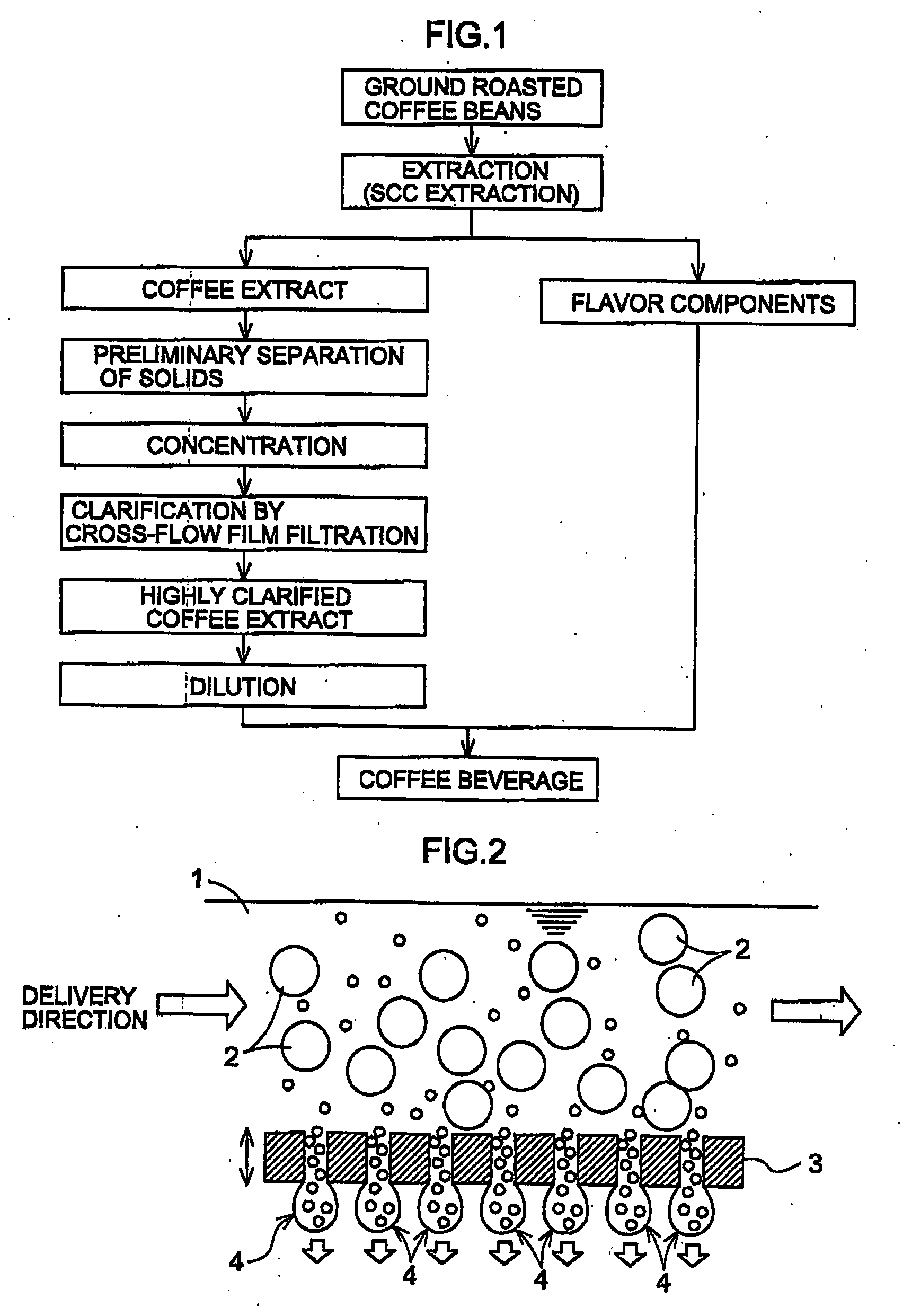Method for Manufacturing Coffee Beverage Using Filtered Extract
a technology of filtered extract and coffee beverage, which is applied in the field of coffee beverage manufacturing, can solve the problems of extremely serious problems for beverage manufacturers, and achieve the effects of reducing production costs, reducing production costs, and being convenient for shipping or storag
- Summary
- Abstract
- Description
- Claims
- Application Information
AI Technical Summary
Benefits of technology
Problems solved by technology
Method used
Image
Examples
example 1
[0060]50 kg of roasted coffee beans were ground along with 450 kg of water in a wet grinder. This mixture was subjected to extraction in an SCC extraction apparatus (Flavourtech M1,000) at 100° C. and a supply flow rate of 350 L / hr. As a result, a coffee extract having a Brix value of 3.4 was obtained. The resulting coffee extract was processed using a centrifugal separator in order to remove excess solids and then concentrated to a Brix value of 29.9 in a thin-film vacuum-type concentrator to obtain a concentrated coffee liquid.
[0061]100 g of the concentrated coffee liquid was diluted to a Brix value of 1.0 using pure water, and precipitation was forcibly initiated in order to measure the precipitating components contained in the concentrated coffee liquid. After centrifugal separation at 6300 rpm for 5 minutes, the supernatant was removed. The result of measuring the weight of the remnants was 17.4 g (wet weight), which is an extremely high value. This concentrated coffee liquid w...
example 2
[0071]Canned milk coffee bevels were prepared using the three aforedescribed samples (Invention 1, Invention 2, and Comparative article 1). The composition ratio of the amount of concentrated coffee liquid to the total amount of coffee raw materials (expressed as solids) was 30%. Extracts from a standard drip method were used for the other coffee raw materials. Sugar, milk, and the like were added in equal amounts to each extract; the cans were sealed; and caned milk coffee beverages were prepared and named Invention 3, Invention 4, and Comparative article 3, respectively. The coffee beverages were subjected to a storage test (55° C. for 1 month), and the state of precipitation was visually observed. None of the beverages had any precipitation when storage began. The results are shown in Table 2.
TABLE 2Precipitation after storage testInvention 3−Invention 4−Comparative article 3+(−: none; +: present)
[0072](−: none; +: present)
[0073]Precipitation did not occur in Invention 3 and Inve...
example 3
[0074]50 kg of roasted coffee beans (a mixture of Brazilian, Colombian, and Guatemalan beans) were mixed with water in a 1:9 ratio and ground to a particle diameter of approximately 1 mm. This liquid was fractionated into volatile components and extract liquid using a Flavourtech SCC (Spining Corn Column) M1,000, which is a type of gas-liquid countercurrent contact extraction apparatus, operating under the conditions below.
[0075]Raw-material supply rate: 350 L / hr
[0076]Vapor flow volume: 17.5 kg / hr
[0077]Amount of vaporization: 17.5 kg / hr
[0078]Temperature at bottom of column: 100° C.
[0079]Temperature at top of column: 100° C.
[0080]Extent of vacuum: Atmospheric pressure
[0081]The volatile components were recovered with the water vapor. The resulting volatile components were immediately cooled to 20° C. or less, and 25 liters of an aqueous solution (Brix value 0.2) containing flavor components was obtained. A Brix value of 3.4 was measured for the extract liquid. This coffee extract was ...
PUM
 Login to View More
Login to View More Abstract
Description
Claims
Application Information
 Login to View More
Login to View More - R&D
- Intellectual Property
- Life Sciences
- Materials
- Tech Scout
- Unparalleled Data Quality
- Higher Quality Content
- 60% Fewer Hallucinations
Browse by: Latest US Patents, China's latest patents, Technical Efficacy Thesaurus, Application Domain, Technology Topic, Popular Technical Reports.
© 2025 PatSnap. All rights reserved.Legal|Privacy policy|Modern Slavery Act Transparency Statement|Sitemap|About US| Contact US: help@patsnap.com


